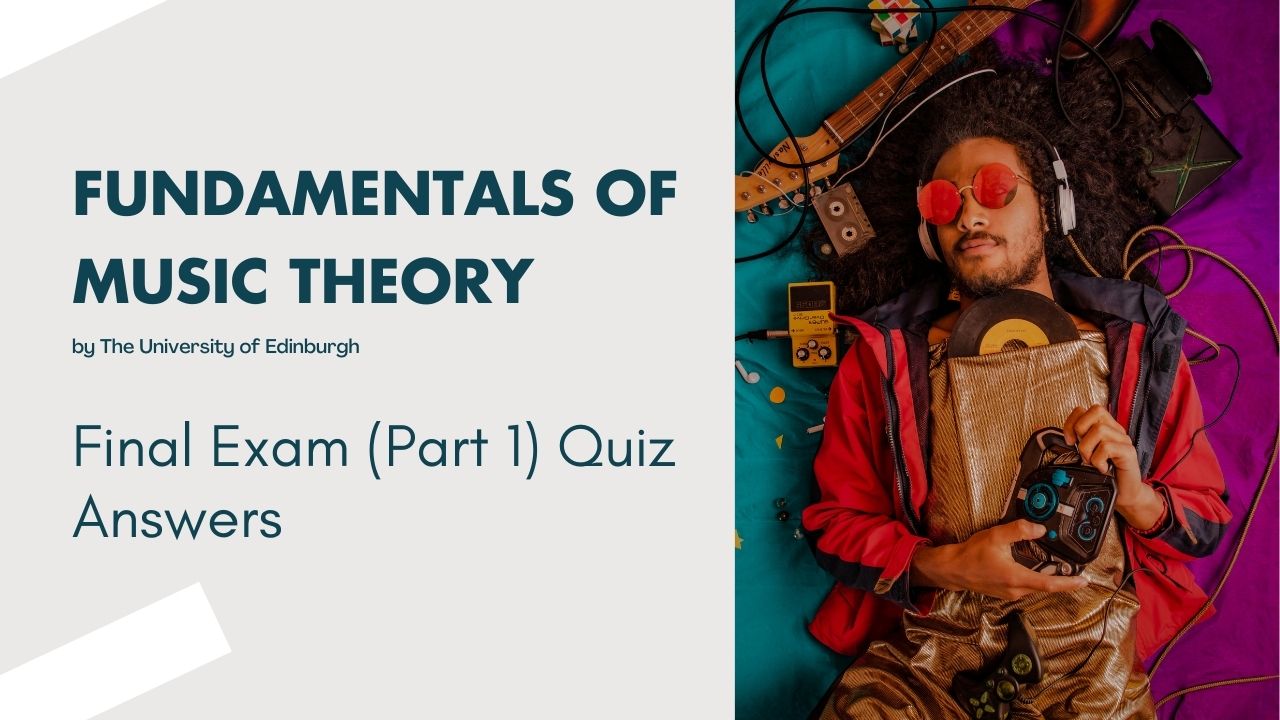In this article i am gone to share Fundamentals of Music Theory Final Exam (Part 1) Quiz Answers with you.. | Fundamentals of Music Theory by The University of Edinburgh
Fundamentals of Music Theory Final Exam (Part 1) Quiz Answers
Question 1)
What key is the excerpt in?
- F# Minor
- A Major
- E Major
- C# Minor
- B Major
Question 2)
Go to bar bar 1, second beat: what is this chord?
(Remember ‘a’ denotes a root position chord, ‘b’ denotes a chord in first inversion etc. Also remember to look at both staves!).
Tick ALL options that describe some aspect of this chord. (2 marks available)
- V7b
- iii
- Ib
- The relative minor
- Ic
- The tonic chord
- The subdominant chord
Question 3)
On bar 4, second beat: what chord is this (hint: how is it related to the following chord)?
Select ALL options that are appropriate. (2 marks available)
- V7/V (V7 of V)
- E7
- F# minor 7
- V/ii (V of ii)
- B minor 7
- ii7
- F#7 (F# dominant 7)
Question 4)
Go to bar 8, then look at the top stave only. On the first beat, two notes are sounding: name the interval.
- Major second
- Fourth
- Minor third
- Diminished fifth
- Augmented second
Question 5)
Look at the uppermost note in on beat 2 of bar 12 (top stave): What is the enharmonic equivalent of this note?
E natural- F#
- A natural
Ab- G natural
Question 6)
Look at bar 12 top stave, second beat: what is this interval?
- Fourth
- Augmented third
- Augmented fourth
- Diminished fifth
- Fifth
Question 7)
Look at bar 12 again. Identify the chords on beats 2 and 3: what is this progression? Select ALL appropriate descriptions. (3 marks)
- D# major to G# minor
- V of the Dominant (V/V)
- V/iii (the V of the iii chord)
- A# minor to G# major
- V of the ii (V/ii)
- An imperfect cadence
- A perfect cadence in the relative minor of the Dominant
- An interruptded cadence in G# major
Question 8)
In bar 19, on the top stave there is a quintuplet. We have removed the stems and beams and left only the note heads, with the ‘5’ symbol meaning quintuplet. Using the other notes in the bar, deduce what duration/time value this quintuplet should occupy
- Semiquaver or sixteenth note
- Crotchet or quarter note
- Quaver or eighth note
- Demisemiquaver or thirty second note
Question 9)
Looking at the same quintuplet as question 9 in bar 19. Assuming all five notes are of equal rhythmical value, how many beams do the 5 notes need? In other words, what note values should each of the quintuplets be made of?
- two beams – semiquavers/16th
- one beam- quavers 8th
- Three beams – demisemiquaver/32nd
- no beams – a crotched/quarter note
Question 10)
What is the first chord in bar 14? Select ALL options that could describe (or partly describe) this chord (3 marks)
- V9b
- V/ii
- The dominant
- The Subdominant
- ii7b
- Vb
- V/V
- IVb
- The Supertonic
Question 11)
Look at the D# in the top stave of bar 18. How else could this tied rhythm be written?
- Dotted quaver/eighth note:
- double dotted crotchet/quarter note:
- Minim/half note:
- double dotted crotchet/quarter note:
Question 12)
Look at bar 28 on the last beat of the top stave. There is a E in the second voice (on beat 3): how long is this E in terms of semiquavers/16ths?
- Four semiquavers/16ths
- Three semiquavers/16ths
- Five semiquavers/16ths
- Six semiquavers/16ths
Question 13)
Go to bar 25 (the second repeat). On beats 1 and 2: what is this chord? (On beats one and two, there are melodic lines in quavers. These notes are effectively part of the chord). Tick ALL options that describe, or partly describe this chord. (3 marks)
- F#7b9
- IV chord
- The dominant of the relative minor V/vi
- The dominant 7 of E major
- B7
- F#7
- V7/V
- F# minor


Can you do Nanophotonics and Detectors in coursera?